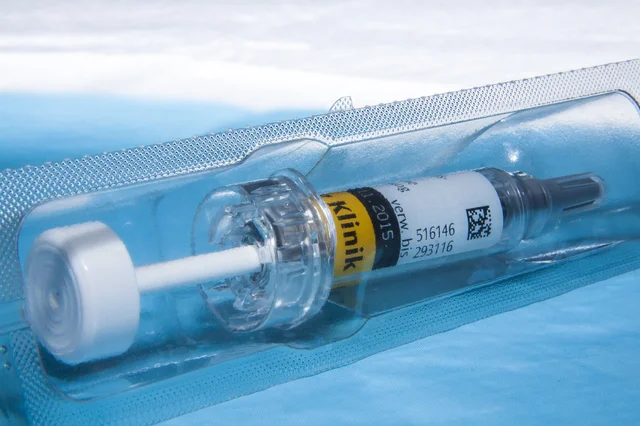Enoxaparin - A Comprehensive Guide
Enoxaparin is also known as Clexane or Lovenox . It Is an anticoagulant that prevents blood clots in the body. Enoxaparin belongs to a group of drugs called low-molecular weight heparins, which is used to lower the risk of thromboembolic conditions such as stroke, deep vein thrombosis and pulmonary embolism. Enoxaparin can be prescribed for patients recovering from hip and knee replacement surgeries or medical procedures that require a long period of bedrest.
Enoxaparin is a coagulation inhibitor that works by interacting with certain proteins within the body. Enoxaparin works by preventing the normal functioning of these proteins. This reduces the chance that clots will form. Note that enoxaparin doesn't dissolve existing blood clots but prevents them from forming new ones.

Enoxaparin: Uses and Benefits
Enoxaparin reduces the risk of stroke, deep vein thrombosis and pulmonary embolism. Most commonly, it is used by patients with recent surgeries, such as hip or knee replacements. It can also be prescribed for medical procedures that require prolonged bed rest. Enoxaparin can also reduce stroke and heart attack risk in patients who have unstable angina, or myocardial infarction without Q-waves.
Enoxaparin, in addition to having anticoagulant effects, has also been proven to have antithrombotic and antiinflammatory properties. In several studies , enoxaparin has been shown to reduce the swelling of blood vessels. This can decrease the chances of complications.
Enoxaparin: Benefits purported
Enoxaparin reduces the risk of stroke, deep vein thrombosis and pulmonary embolism. Enoxaparin has been shown to reduce the risk of thromboembolic events, including deep vein thrombosis, stroke, and pulmonary embolism, more effectively than Warfarin in several clinical studies . Enoxaparin was also found to reduce the risk of venous embolism following hip or knee replacement surgery more effectively than unfractionated Heparin.
Enoxaparin also reduces the risk of stroke and heart attack in patients who have unstable angina, or myocardial infarction without Q-wave. It has also been shown to lower the risk of cardiac arrest death in patients with Acute Coronary Syndrome.
Enoxaparin also has anti-inflammatory effects and is antithrombotic, so it can reduce the swelling of blood vessels. This will help to decrease further complications.
Enoxaparin Side Effects
Enoxaparin can cause a variety of side effects, including: bleeding, bruises, redness and swelling, pain, irritation, rash, breathing difficulties, rapid heartbeat, nausea, vomiting and diarrhea. Other side effects such as allergic reactions may be more serious.
You should check with your physician before you take any other medication while taking enoxaparin. Enoxaparin is not recommended during pregnancy as it can harm the baby.
Experts or professionals' opinions on Enoxaparin
The majority of experts are in agreement that enoxaparin can be used as an anticoagulant without causing any harm. It has been shown in studies that enoxaparin is more effective at reducing the risks of thromboembolic conditions, including deep vein thrombosis and stroke, than warfarin or other anticoagulants. It has also been shown to reduce the risk of venous embolism following hip or knee replacement surgery more effectively than unfractionated Heparin.
Enoxaparin generally has few side effects. However, some people may have minor ones such as bruising or bleeding, pains, itching and rash. Other side effects include dizziness, headaches, nausea, vomiting or diarrhea. It is also possible to experience serious side effects such as an allergic reaction. If you notice any of the symptoms, it's important that you speak with your doctor.
Enoxaparin: How To Get Started
Enoxaparin injections are usually given under the skin. A daily dose of 30mg is the usual. The dose can be adjusted according to the medical condition of the patient. Rotate the injection site to prevent irritation and infection. When taking enoxaparin, it is very important that you follow your doctor's directions.
Enoxaparin comes in prefilled vials and syringes. Store it in a refrigerator. The product should never be exposed to heat, sunlight or freezing. Keep it out of the reach of kids.
Conclusion
Enoxaparin, an anticoagulant, is prescribed to lower the risk of stroke, deep vein thrombosis and pulmonary embolism. Most commonly, it is prescribed to patients who recently had hip or knee surgery or any other procedure that requires a long period of bedrest. Enoxaparin is more effective in reducing these risks than other anticoagulants such as warfarin.
Enoxaparin generally has a good tolerance, but some patients can experience mild side effects, such as bruising or bleeding, swelling, pain, discomfort, rashs, breathing difficulties, rapid heartbeats, headaches, nausea and vomiting. Other side effects such as allergic reactions can be more serious. If you notice any of the symptoms, it is vital that you speak with your doctor.
Enoxaparin injections are usually given under the skin. A daily dose of 30mg is the usual. The dose can be adjusted depending on the medical condition of the patient. When taking enoxaparin, it is very important that you follow your doctor's directions.
Conclusion: Enoxaparin has proven to be a highly effective and safe anticoagulant that reduces the risk of stroke, deep vein thrombosis and pulmonary embolism. It is still important to consult your doctor in the event that you have any adverse effects from taking enoxaparin.
.